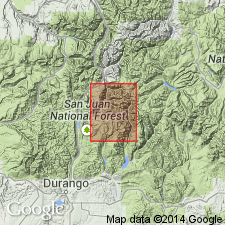
- Usage in publication:
-
- Vallecito conglomerate*
- Modifications:
-
- Original reference
- Dominant lithology:
-
- Conglomerate
- Grit
- Sandstone
- AAPG geologic province:
-
- Southern Rocky Mountain region
Summary:
Vallecito conglomerate of Needle Mountains group. A heavy conglomerate exposed on both sides of Vallecito Creek for about 1 mile north from south boundary of quadrangle. Is better exposed on Pine River. Thickness 2,000 or more feet. Contact (conformable) with overlying Uncompahgre formation is shown to east of quadrangle, in Pine River drainage. The Vallecito conglomerate and Uncompahgre formation compose Needle Mountains group in this area. [See also under Needle Mine group.] [Age is pre-Cambrian.]
[GNC remark (ca. 1936, US geologic names lexicon, USGS Bull. 896, p. 2228): For many years this formation was classified as "Algonkian," but the terms "Algonkian system" and "Archean system" having been discarded by the USGS the formation is now classified as pre-Cambrian.]
Source: US geologic names lexicon (USGS Bull. 896, p. 2228).
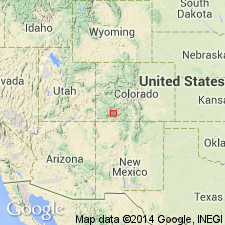
- Usage in publication:
-
- Vallecito Conglomerate*
- Modifications:
-
- Overview
- AAPG geologic province:
-
- Southern Rocky Mountain region
Summary:
Deposition and intrusion sequence considered different here than described in earlier reports. Vallecito is the oldest Precambrian unit in Needle Mountains, La Plata Co, CO in the Southern Rocky Mountain region. Is found only in the Needle Mountains and is especially well exposed in canyons and cliff walls along the Pine River. Consists of metaconglomerate and pebbly quartzite. The clasts are subangular to round fragments of milky quartz, red and black jasper, chert, gray argillite, ferruginous quartzite, iron-formation, intermediate volcanic rocks, epidote-rich greenschist, and muscovite schist. The clasts range from 1 mm to about 1 ft, but few are larger than 4 in. Matrix is a gray, poorly sorted aggregate of quartz and sericite with minor hematite, leucoxene, garnet, albite, biotite epidote. Is mostly gray, locally pink or purple. Thickness uncertain; thought to be more than 2,400 ft thick. Recrystallized during metamorphism as evidenced by occurrence of quartz into polygranular fabric, alignment of sericite; garnets enclosed in sericite may be metamorphic, rather than detrital, and epidote grains rarely rounded suggesting detrital origin and later recrystallization. Is older than Irving Formation. Geologic sketch map. May be of deltaic origin; fluvial origin implied.
Source: GNU records (USGS DDS-6; Denver GNULEX).
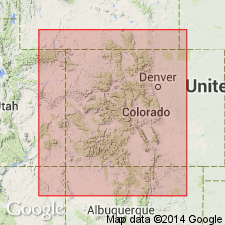
- Usage in publication:
-
- Vallecito Conglomerate*
- Modifications:
-
- Overview
- AAPG geologic province:
-
- Southern Rocky Mountain region
Summary:
Included with rocks of pre-1,700 m.y., or Precambrian X, metamorphic complex. Used in Needle Mountains area.
Source: GNU records (USGS DDS-6; Denver GNULEX).
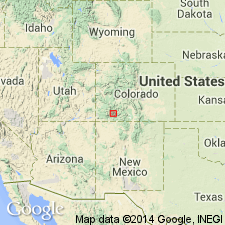
- Usage in publication:
-
- Vallecito Conglomerate
- Modifications:
-
- Revised
- AAPG geologic province:
-
- Southern Rocky Mountain region
Summary:
Contact relation of Uncompahgre Formation with Vallecito is uncertain; neither has been dated radiometrically and no common contact exists between them. Shown as probably a thrust contact on figure 1.
Source: GNU records (USGS DDS-6; Denver GNULEX).
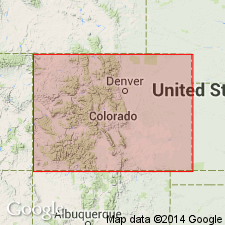
- Usage in publication:
-
- Vallecito Conglomerate*
- Modifications:
-
- Overview
Summary:
Composed of massive conglomerate, pebbly quartzite and quartzite. Is at least 1,525 m (5,000 ft) thick. Clasts in basal part same as those in Irving Formation. Trough-type cross beds in almost all quartzite beds. Exposed in an area 50 sq km in southeast Needle Mountains between Hinsdale and La Plata Cos. Closely related in age and origin to the Uncompahgre Formation. Thought to be younger than Irving and older than the 1,440 m.y. Eolus Granite. Was probably an alluvial-fan deposit that prograded southward from a source area. Vallecito and Uncompahgre are both considered to be Early and Middle Proterozoic.
Source: GNU records (USGS DDS-6; Denver GNULEX).
For more information, please contact Nancy Stamm, Geologic Names Committee Secretary.
Asterisk (*) indicates published by U.S. Geological Survey authors.
"No current usage" (†) implies that a name has been abandoned or has fallen into disuse. Former usage and, if known, replacement name given in parentheses ( ).
Slash (/) indicates name conflicts with nomenclatural guidelines (CSN, 1933; ACSN, 1961, 1970; NACSN, 1983, 2005, 2021). May be explained within brackets ([ ]).

